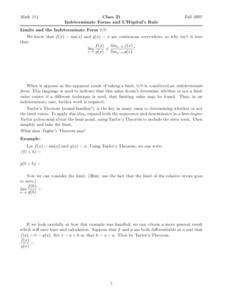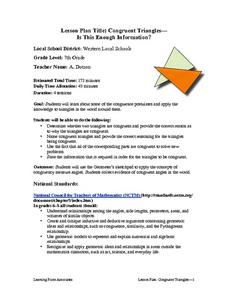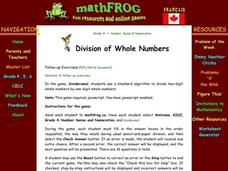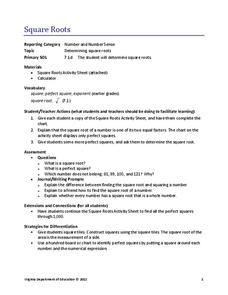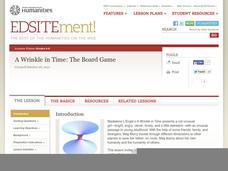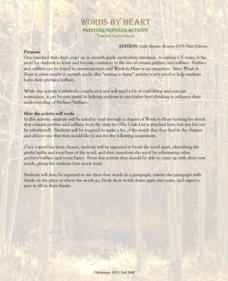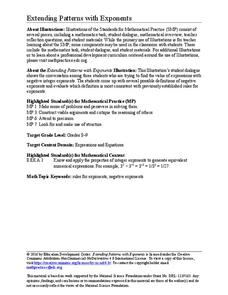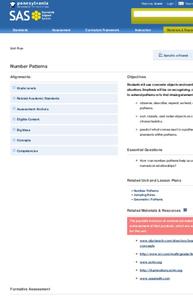Curated OER
Converting among Units
In this conversion worksheet, student use the factor-label method or unit analysis method to convert given measurements from one unit to another unit.
Curated OER
Indeterminate Forms and L'Hopital's Rule
In this limits worksheet, students use Taylor's Theorem to solve two short answer problems. They use L'Hopital's Rule to solve two short answer problems. Students read a two page lesson on limits.
Curated OER
Congruent Trianges - Is This Enough Information?
Seventh graders determine whether two triangles are congruent and provide an explanation to why they are not. They apply concepts of measurement of angles and collect evidence of congruent angles in the world.
Curated OER
The Golden Ratio
Seventh graders investigate a ratio found in nature and in numerous pieces of artwork throughout history. The lesson is cross-curricular and builds a sense of appreciation of design for students.
Curated OER
Tower of Hanoi Lesson Plan
Students investigate the Legend of the Tower of Hanoi and complete mathematical problems related to the legend. They play the Tower of Hanoi game online in order to discover the number pattern involved. They solve problems using the...
Curated OER
Division of Whole Numbers
Students divide two-digit numbers by one-digit whole numbers. Using a specified website, they play complete standard division algorithms. Students receive immediate feedback on the website. In addition, they complete problems on paper.
Curated OER
Order of Operations
Sixth graders, while in the computer lab, participate in the Order of Operations game where they must complete as many questions involving two operations as possible in 120 seconds. They review the summary of his/her performance when it...
Virginia Department of Education
Square Roots
Square away any doubts about using a new resource. Pupils learn about squares and square roots in the mini-lesson. They complete a worksheet identifying roots of perfect squares up to 400.
National Endowment for the Humanities
A Wrinkle in Time: The Board Game
Tackle some big questions about A Wrinkle in Time by Madeleine L'Engle with a board game project. As learners brainstorm for and complete their board games, they consider what helps and hinders Meg on her journey and why she succeeds in...
California Education Partners
Photos
Why do all sizes of pictures not show the same thing? Class members analyze aspect ratios of various sizes of photos. They determine which sizes have equivalent ratios and figure out why some pictures need to be cropped to fit...
Novelinks
Words by Heart: Prefixes/Suffixes Activity
This lesson is so beneficial it makes any teacher's heart skip a beat! After readers identify words from Words by Heart, they break down unknown vocabulary with a handout detailing various prefixes and suffixes. Once they finish...
Education Development Center
Extending Patterns with Exponents
Don't think negatively about exponents. Young mathematicians dissect a fictional conversation between pupils trying to evaluate an expression with a negative exponent. This allows them to understand the meaning of negative exponents.
University of Nottingham
Drawing to Scale: A Garden
See how design and geometry go hand in hand. The activity asks learners to use geometry to design a backyard garden given dimensions of each feature. Scholars work with ratios and scale to develop an accurate scale drawing that includes...
Polar Trec
Global Snow Cover Changes
Snow is actually translucent, reflecting light off its surface which creates its white appearance. Pairs or individuals access the given website and answer questions about snow cover. They analyze graphs and charts, examine data, and...
Curated OER
Fraction Models
Third graders make models of fractions and mixed numbers. Using fraction strips and drawing pictures, 3rd graders develop conceptual understanding of the equivalent forms. Students use the number line to represent and compare...
Curated OER
Counting Farm Animals
Very simply, fledgling farmers count farm animals, trace the numbers, and then draw a line to connect them to the matching set on the other half of the page. Because the correct number is listed right next to each group of animals, this...
Curated OER
Number Patterns
First graders use manipulatives to complete and extend patterns. In this patterns lesson, 1st graders complete a pattern with a missing element, extend a pattern, and sort objects by characteristics.
Curated OER
Patterns
Second graders create an ABAB pattern with their name. For this early elementary math lesson, 2nd graders first model their names in an ABAB pattern with unifix cubes. They then recreate the pattern using letter stamps on KidPix.
Curated OER
Veggie Chop and Data Analysis
First graders chop vegetables into fractions. In this fractions lesson, 1st graders cut vegetables, collect data about favorite vegetables and create a bar graph using the information. Students make inferences about the data and...
Curated OER
Basic Sense
Fifth graders add fractions. After a class discussion on real life application of fractions, the teacher uses fractions strips to model adding fractions. In pairs, 5th graders model adding fractions by drawing diagrams. They justify...
Curated OER
Numbers, Time, Dates, and Prices
In this reading numbers worksheet, learners say a series of varying numbers. Students practice saying ordinal numbers, time of the day, dates of the year, fractions, and prices. Learners also write numbers for their address, birthday,...
Curated OER
Time and Earth History Socratic Questions
Students develop a sense of geologic ("deep") time and the ways in which Earth scientists construct the geologic time scale. They study he major events that shaped Earth, including the origin and evolution of its lithosphere, atmosphere,...
Curated OER
Discovering Shoes, Step by Step
Learners discuss and write about their interpretations of the art. They compare and contrast the numerous types of shoes and how they are used in a certain time and place. Students memorize the Shel Silverstein's poem, "Ickle Me, Pickle...
Curated OER
Name Games
Students develop a sense of self. They complete several activities involving their name. They disuss what names are useful for safety purposes.

